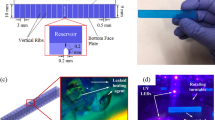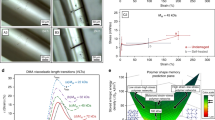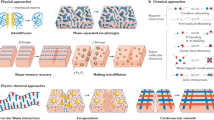Abstract
Self-healing polymers composed of microencapsulated healing agents exhibit remarkable mechanical performance and regenerative ability1,2,3, but are limited to autonomic repair of a single damage event in a given location. Self-healing is triggered by crack-induced rupture of the embedded capsules; thus, once a localized region is depleted of healing agent, further repair is precluded. Re-mendable polymers4,5 can achieve multiple healing cycles, but require external intervention in the form of heat treatment and applied pressure. Here, we report a self-healing system capable of autonomously repairing repeated damage events. Our bio-inspired coating–substrate design delivers healing agent to cracks in a polymer coating via a three-dimensional microvascular network6 embedded in the substrate. Crack damage in the epoxy coating is healed repeatedly. This approach opens new avenues for continuous delivery of healing agents for self-repair as well as other active species for additional functionality.
This is a preview of subscription content, access via your institution
Access options
Subscribe to this journal
Receive 12 print issues and online access
$259.00 per year
only $21.58 per issue
Buy this article
- Purchase on Springer Link
- Instant access to full article PDF
Prices may be subject to local taxes which are calculated during checkout



Similar content being viewed by others
References
White, S. R. et al. Autonomic healing of polymer composites. Nature 409, 794–797 (2001).
Brown, E. N., Sottos, N. R. & White, S. R. Fracture testing of a self healing polymer composite. Exp. Mech. 42, 372–379 (2002).
Brown, E. N., White, S. R. & Sottos, N. R. Retardation and repair of fatigue cracks in a microcapsule toughened epoxy composite—part II: In situ self-healing. Compos. Sci. Technol. 65, 2474–2480 (2005).
Chen, X. et al. A thermally re-mendable cross-linked polymeric material. Science 295, 1698–1702 (2002).
Chen, X., Wudl, F., Mal, A. K., Shen, H. & Nutt, S. R. New thermally remendable highly cross-linked polymeric materials. Macromolecules 36, 1802–1807 (2003).
Therriault, D., White, S. R. & Lewis, J. A. Chaotic mixing in three-dimensional microvascular networks fabricated by direct-write assembly. Nature Mater. 2, 265–271 (2003).
Runyon, M. K., Johnson-Kerner, B. L. & Ismagilov, R. F. Minimal functional models of hemostasis in a biomimetic microfluidic system. Angew. Chem. Int. Edn 43, 1531–1536 (2004).
Stroock, A. D. & Cabodi, M. Microfluidic biomaterials. Mater. Res. Soc. Bull. 31, 114–119 (2006).
Lim, D., Kamotani, Y., Cho, B., Mazumder, J. & Takayama, S. Fabrication of microfluidic mixers and artificial vasculartures using a high-brightness diode-pumped Nd:YAG laser direct write method. Lab Chip 3, 318–323 (2003).
Martin, P. Wound healing—Aiming for perfect skin regeneration. Science 276, 75–81 (1997).
Nagaya, K., Ikai, S., Chiba, M. & Chao, X. Tire with self-repairing mechanism. JSME Int. J. 49, 379–384 (2006).
Sonntag, P. et al. Biocide squirting from an elastomeric tri-layer film. Nature Mater. 3, 311–315 (2004).
Kessler, M. R., Sottos, N. R. & White, S. R. Self-healing structural composite materials. Compos. Part. A 34, 743–753 (2003).
Brown, E. N., White, S. R. & Sottos, N. R. Microcapsule induced toughening in a self-healing polymer composite. J. Mater. Sci. 39, 1703–1710 (2004).
Brown, E. N., White, S. R. & Sottos, N. R. Retardation and repair of fatigue cracks in a microcapsule toughened epoxy composite—part I: Manual infiltration. Compos. Sci. Technol. 65, 2466–2473 (2005).
Jones, A. S., Rule, J. D., Moore, J. S., White, S. R. & Sottos, N. R. Catalyst morphology and dissolution kinetics for self-healing polymers. Chem. Mater. 18, 1312–1317 (2005).
Therriault, D. Directed Assembly of Three-Dimensional Microvascular Networks. Thesis, Univ. of Illinois at Urbana-Champaign (2003).
Rule, J., Brown, E. N., Sottos, N. R., White, S. R. & Moore, J. S. Wax-protected catalyst microspheres for efficient self-healing materials. Adv. Mater. 72, 205–208 (2005).
Bond, I. & Pang, J. ‘Bleeding composites’—enhanced damage detection and self repair using a biomimetic approach. Compos. Part. A 36, 183–188 (2005).
Schwab, P., Grubbs, R. H. & Ziller, J. W. Synthesis and applications of RuCl2(=CHR′)(PR3)2: The influence of the alkylidene moiety on metathesis activity. J. Am. Chem. Soc. 118, 100–110 (1996).
Kim, S.-R. & Nairn, J. A. Fracture mechanics analysis of coating/substrate systems part I: Analysis of tensile and bending experiments. Eng. Fract. Mech. 65, 573–593 (2000).
Kim, S.-R. & Nairn, J. A. Fracture mechanics analysis of coating/substrate systems part II: Experiments in bending. Eng. Fract. Mech. 65, 595–607 (2000).
Nairn, J. A. & Kim, S.-R. A fracture mechanics analysis of multiple cracking in coatings. Eng. Fract. Mech. 42, 195–208 (1992).
Acknowledgements
This work has been financially supported by the Air Force Office of Scientific Research Multidisciplinary University Research Initiative (grant number F49550-05-1-0346). K.S.T. is supported in part by the Beckman Institute for Advanced Science and Technology Graduate Fellows Program. We extend our gratitude to the Imaging Technology Group at the Beckman Institute, especially S. Robinson, for assistance with scanning electron microscopy.
Author information
Authors and Affiliations
Contributions
K.S.T. carried out all of the experiments and analysis. N.R.S. and S.R.W. conceived the microvascular substrate–coating experiment and directed the research. J.A.L. and S.R.W. developed the direct-write manufacturing method. J.S.M. assisted with the healing chemistry. All authors participated in discussions of the research and wrote the manuscript.
Corresponding author
Ethics declarations
Competing interests
The authors declare no competing financial interests.
Supplementary information
Supplementary Information
Supplementary information, scheme 1 and figures S1-S3 (PDF 277 kb)
Rights and permissions
About this article
Cite this article
Toohey, K., Sottos, N., Lewis, J. et al. Self-healing materials with microvascular networks. Nature Mater 6, 581–585 (2007). https://doi.org/10.1038/nmat1934
Received:
Accepted:
Published:
Issue Date:
DOI: https://doi.org/10.1038/nmat1934
This article is cited by
-
Synthesis, Mechanism, and Applications of Self-healing Materials
Biomedical Materials & Devices (2024)
-
Recent Advances in Liquid Metal-Based Flexible Devices with Highly Sensitive, Plastic and Biocompatible in Bionic Electronics
Biomedical Materials & Devices (2024)
-
Autonomous healing of fatigue cracks via cold welding
Nature (2023)
-
State of Art Review on Applications and Mechanism of Self-Healing Materials and Structure
Archives of Computational Methods in Engineering (2023)
-
Emerging trends in self-healable nanomaterials for triboelectric nanogenerators: A comprehensive review and roadmap
Frontiers in Energy (2023)



